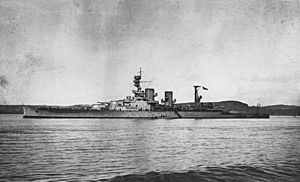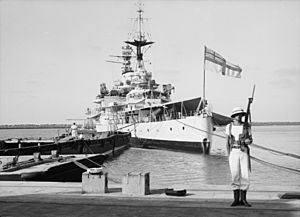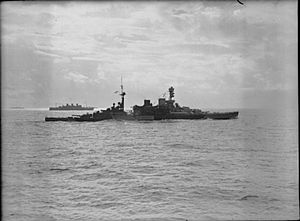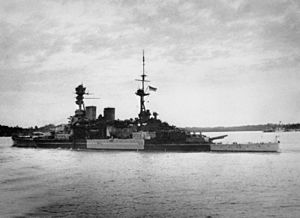HMS Repulse (1916) facts for kids

Repulse on manoeuvres in the 1920s
|
|
Quick facts for kids History |
|
|---|---|
| Name | Repulse |
| Ordered | 30 December 1914 |
| Builder | John Brown & Company, Clydebank, Scotland |
| Laid down | 25 January 1915 |
| Launched | 8 January 1916 |
| Commissioned | 18 August 1916 |
| Identification | Pennant number: 34 |
| Motto |
|
| Nickname(s) | Repair |
| Fate | Sunk by Japanese bombers, 10 December 1941 |
| General characteristics (as built) | |
| Class and type | Renown-class battlecruiser |
| Displacement | |
| Length |
|
| Beam | 90 ft 1.75 in (27.5 m) |
| Draught | 27 ft (8.2 m) |
| Installed power |
|
| Propulsion | 4 × shafts, 2 × Steam turbine sets, |
| Speed | 31.5 knots (58.3 km/h; 36.2 mph) |
| Crew |
|
| Armament |
|
| Armour |
|
| General characteristics (1939) | |
| Displacement | 34,600 long tons (35,200 t) |
| Length | 794 ft 2.5 in (242.1 m) (o/a) |
| Beam | 89 ft 11.5 in (27.4 m) |
| Draught | 29 ft 8 in (9 m) |
| Installed power | 112,000 shp (84,000 kW) |
| Propulsion | 4 × shafts, 4 × direct-drive steam turbines |
| Speed | 30.5 knots (56.5 km/h; 35.1 mph) |
| Range | 3,650 nmi (6,760 km; 4,200 mi) |
| Complement | 1,181 |
| Armament |
|
| Armour |
|
| Aircraft carried | 4 × seaplanes |
| Aviation facilities | 1 × aircraft catapult |
HMS Repulse was a powerful warship called a battlecruiser. She was built for the Royal Navy (Britain's navy) during World War I. Repulse was designed to be very fast and carry large guns. Her sister ship was Renown. These two ships were the fastest large warships in the world when they were finished.
Repulse saw some action in 1917 during the Second Battle of Heligoland Bight. This was her only battle during World War I. Between the two World Wars, she was updated twice. These updates made her stronger and improved her features. Repulse also sailed around the world in 1923–1924 with another famous battlecruiser, Hood. Later, she helped protect ships during the Spanish Civil War from 1936 to 1939.
When World War II began, Repulse hunted for German ships. She took part in the Norwegian Campaign in 1940. In 1941, she helped search for the German battleship German battleship Bismarck. Later that year, Repulse sailed to Asia. She joined Force Z to help stop Japanese attacks in the Far East. Sadly, on 10 December 1941, Repulse and Prince of Wales were sunk by Japanese aircraft. This happened when they tried to stop Japanese landings in British Malaya.
Contents
Building and Features of HMS Repulse
Admiral Lord Fisher, a leader in the Royal Navy, wanted new, fast warships. He asked for a design on 18 December 1914. He wanted a long ship with a high front, like an older ship called Renown. The ship needed four 15-inch guns and many smaller 4-inch guns. It also had to be very fast, reaching 32 knots (about 37 miles per hour).
The shipbuilders started work quickly on 25 January 1915. Repulse was finished on 18 August 1916. She was 794 feet 2.5 inches (242.1 m) long and 89 feet 11.5 inches (27.4 m) wide. Her engines were designed to make 112,000 shaft horsepower (84,000 kW) of power. This allowed her to reach speeds of 31.73 knots (58.76 km/h; 36.51 mph) (about 36.5 miles per hour).
Repulse had six large 15-inch guns in three turrets. She also had 17 smaller 4-inch guns. For air defense, she had two 3-inch anti-aircraft guns. The ship also carried two underwater torpedo tubes. Her side armor was 6 inches (152 mm) thick in the middle. The gun turrets had armor from 7–9 inches (178–229 mm) thick.
After the Battle of Jutland in 1916, more armor was added to her decks. This extra armor helped protect the ship from bombs falling from above. Repulse also had special "bulges" on her sides. These were designed to absorb the blast from torpedoes. In 1917, Repulse was one of the first large warships to have a platform for planes to take off from.
HMS Repulse in Action
Repulse was built by John Brown in Clydebank, Scotland. She was launched on 8 January 1916. The ship cost about £2.8 million to build. She joined the Grand Fleet in the North Sea. Repulse became the flagship of the 1st Battlecruiser Squadron.
World War I Service
Repulse served in the North Sea during World War I. Her main combat action was in 1917.
Battle of Heligoland Bight
On 17 November 1917, British ships planned to attack German minesweepers. These were ships that cleared paths through minefields. Repulse raced forward to join the fight. She fired her large 15-inch guns. She hit the German light cruiser SMS Königsberg once. This slowed the German ship down.
When larger German battleships appeared, the British ships pulled back. Repulse helped cover their retreat. A thick fog helped hide the British ships. Repulse fired 54 shells during this battle. On 12 December 1917, Repulse crashed into another battlecruiser, HMAS Australia. She was present when the German fleet surrendered in 1918.
Between the World Wars
After World War I, Repulse had a big upgrade starting in December 1918. Her old 6-inch armor belt was replaced with thicker 9-inch armor. More armor was added to her decks. Her anti-torpedo bulges were also improved. These changes made her much stronger. This refit cost over £860,000.
Repulse was ready for service again on 1 January 1921. She joined the Battlecruiser Squadron. In November 1923, Repulse went on a world tour with Hood. They sailed through the Panama Canal and returned ten months later. During this time, some of her anti-aircraft guns were updated.
Major Upgrades in the 1930s
Repulse had another big upgrade from 1933 to 1936. Her horizontal armor was replaced with new, thicker plates. A catapult was added to launch seaplanes. Hangars were built on each side of the rear funnel to store two planes. Electric cranes helped move the aircraft.
New anti-aircraft guns were added, including powerful 2-pounder "pom-pom" guns. Machine guns were also installed. Two special directors were added to help aim the anti-aircraft guns. The underwater torpedo tubes were removed.
After her upgrades, Repulse joined the Mediterranean Fleet in April 1936. She helped rescue 500 refugees during the Spanish Civil War. In May 1937, she was part of the fleet review for King George VI. In July 1938, Repulse was sent to Haifa to help keep peace during the Arab Revolt.
World War II Service
At the start of World War II, Repulse patrolled the North Sea. She looked for German ships and helped enforce blockades. In late 1939, she went to Halifax, Canada. Her job was to protect convoys (groups of ships) and search for German raiders.
In February 1940, Repulse searched for German ships that had escaped from Spain. She supported Allied operations during the Norwegian Campaign in April–June 1940. She helped escort troop convoys. Until May 1941, she continued to escort convoys and search for German ships. On 22 May, Repulse joined the hunt for the German battleship German battleship Bismarck. However, she had to stop early because she was running low on fuel.
From June to August, Repulse was refitted. She received new 20 mm anti-aircraft guns and a radar system. She then escorted a troop convoy around the Cape of Good Hope to Asia. She was transferred to the East Indies Command.
The Sinking of Force Z
In late 1941, Winston Churchill sent a group of powerful warships to Singapore. This group, called Force Z, included Repulse and the new battleship Prince of Wales. Their mission was to discourage Japanese attacks in Asia. On 8 December 1941, Force Z left Singapore to stop Japanese troop landings.
Japanese aircraft spotted Force Z on 9 December. Admiral Sir Tom Phillips, the commander, decided to turn back. However, he received a report of Japanese landings at Kuantan. He changed course to intercept them.
On 10 December, Japanese bombers and torpedo planes found Force Z. The first attack began at 11:13. Bombs were dropped from high above. One bomb hit Repulse, going through her hangar. It caused damage and started a fire.
Repulse's captain, Bill Tennant, skillfully avoided many torpedoes. But then, 17 Japanese torpedo bombers attacked at once. Repulse was hit by four or five torpedoes very quickly. The damage was too severe. At 12:23, Repulse leaned heavily to her left side and quickly sank. 508 officers and men were lost. The destroyers Electra and Vampire rescued the survivors, including Captain Tennant.
The Wreck of HMS Repulse
The site where Repulse sank was made a 'Protected Place' in 2002. This means it is protected as a military grave. Survivors said Repulse was hit by five torpedoes. Divers explored the wreck in 2007. They confirmed two torpedo hits. The other reported hits could not be confirmed because parts of the wreck were buried.
In 2014, it was reported that scrap metal dealers were damaging the wrecks of both Prince of Wales and Repulse using explosives.
Images for kids
-
Repulse in the Firth of Forth serving as the flagship of the 1st Battlecruiser Squadron, 1918
-
Repulse entering Vancouver Harbour during her world tour with Hood and other ships of the Special Service Squadron, 1924
-
Repulse in Haifa harbor during the Arab Revolt, July 1938
See also
 In Spanish: HMS Repulse (1916) para niños
In Spanish: HMS Repulse (1916) para niños










